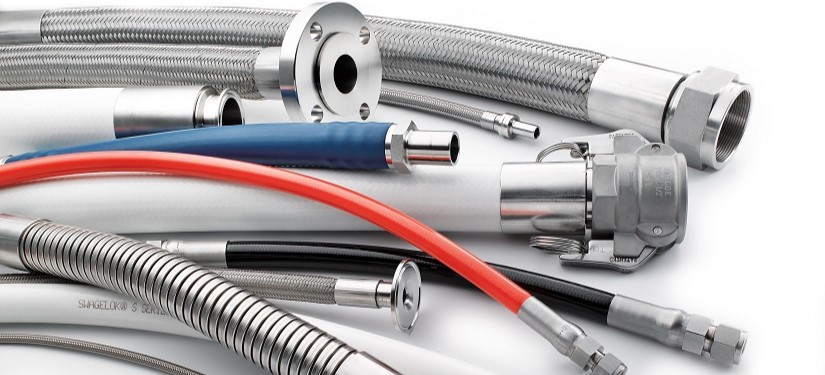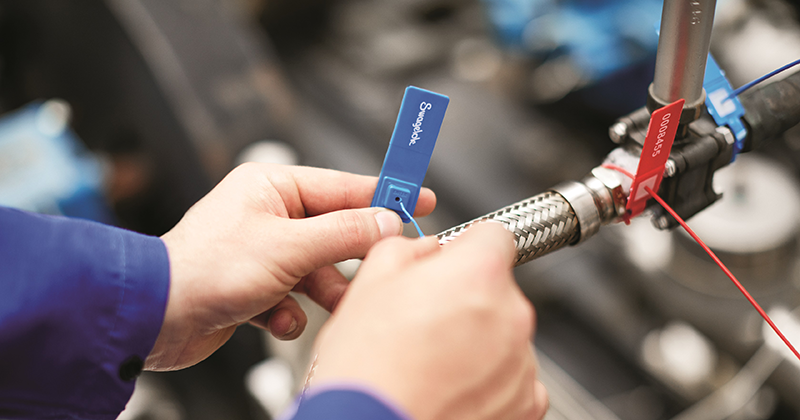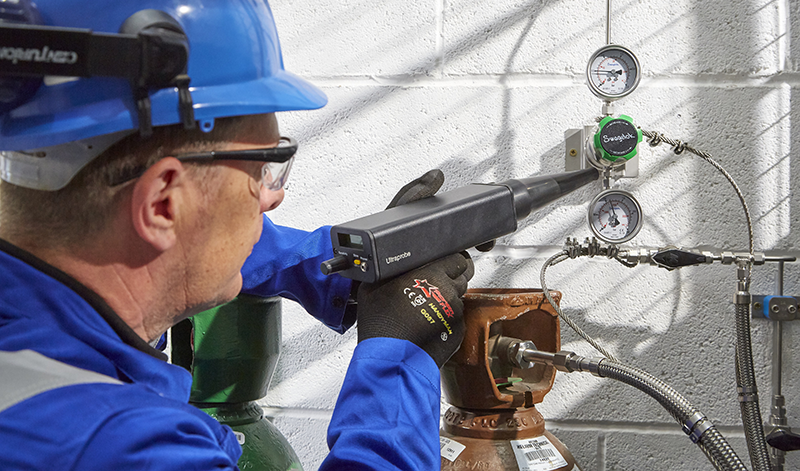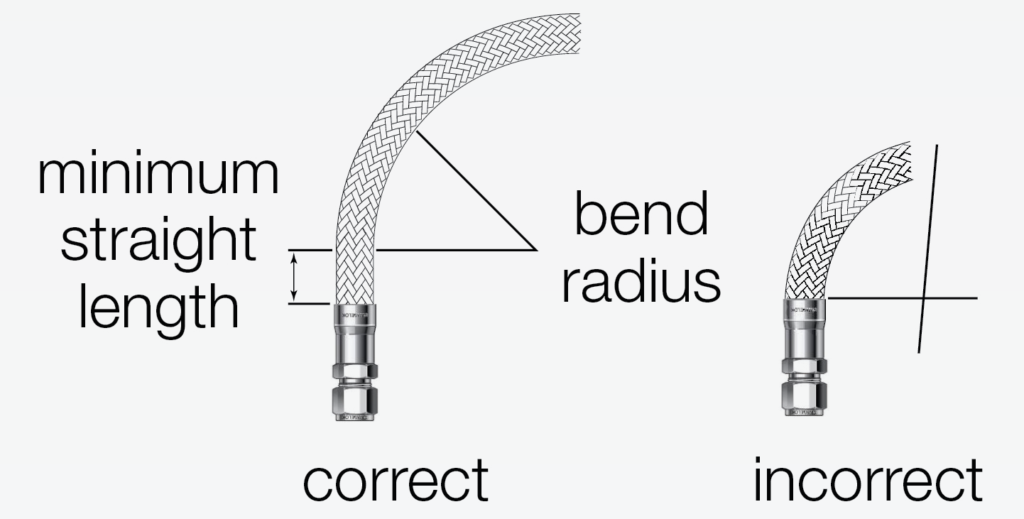
Save money with a proactive industrial hose maintenance plan
By Alice Chin, Field Engineer Supervisor, North America, Swagelok Company
Features
Deciding when to replace your industrial hoses is as much an art as a science. If they are replaced too soon, it can cost unnecessary time and money. Wait too long, and failures could put employees at risk and lead to unplanned downtime.
Putting a preventive maintenance plan in place in addition to standard operating procedures can make the process more precise.
Video demonstration — Do You Know How to Properly Route Hose? Learn best practices to follow when routing and installing hose in your application:
To implement a preventive maintenance plan, it is critical to track the life span and performance of every hose in your facility and inspect them frequently.
Technicians can then replace them proactively and decide which hoses require having spares on-site at any given time. Remember that no two hoses will have the exact same replacement interval.
Creating a sufficient preventive maintenance plan requires you to follow a specific set of steps. This article will provide you with a basic understanding of what those steps are and how they can help save time and money at your facility.
How to Create a Preventive Maintenance Plan for Your Industrial Hoses
Start with the general inspection and replacement guidelines provided by your supplier, with the understanding that specific environmental factors may require you to deviate from them.
How frequently you will need to replace your hoses will depend on the operating environment, what the hoses are made of, and other factors. Do not guess at your replacement intervals — only close inspection and excellent record-keeping will determine the actual time between hose replacements.
Identify All Your Hoses
The process of creating a preventive maintenance plan starts with identifying where your hoses are and labeling each one (Figure 1). Being precise during this initial plant audit will allow you to document the hose types, part numbers, process fluids, pressure or temperature ratings, vendor name, and the contact information for each vendor.

Figure 1. Recording essential information such as hose type and part number will allow maintenance technicians to easily stock the proper replacements.
Once the initial audit is complete, input the information in a spreadsheet. Include additional details like length, size, core material and construction, reinforcement layers, end connections, mounting, and cover type. Also note the operation conditions and cleaning procedures each hose undergoes daily, which will offer insights into how these operations affect the life span of the hose. Lastly, include the date the hose was installed and when it is scheduled to be replaced. If you’re working with a reputable supplier, they may be able to offer you support during this process with evaluation and advisory services.
Determine Each Hose’s Life Cycle
Regular hose inspections are crucial to helping you understand how your hoses are performing in the field and should begin with the inspection interval your supplier suggests. Under normal circumstances, these inspections do not necessitate shutting down the system and can be done visually. Issues you should look for include corrosion, kinks, scrapes, cuts, and general deterioration (Figure 2).

Figure 2. Visual inspections of the hoses should check regularly for scrapes, wear, and leaks, in addition to possibly using ultrasonic and other testing to determine the accurate condition of the hose.
If any of these signs are apparent, it may indicate the hose should be replaced. Do not forget to document the results of these inspections on the spreadsheet. If you determine it is time to replace the hose, note the interval because it will become the known replacement period for that specific hose.
Should the hose fail before its planned replacement interval, you should note the details of its failure carefully. Include the location of the failure, severity, and how it was mounted. Providing these details to your supplier will allow the team to diagnose where and why the problem occurred and facilitate the creation of an action plan to prevent it from becoming a recurring problem.
Eliminate Hose Strain
If possible, perform your inspections while the system is operating, which will give you the opportunity to see what conditions may be unnecessarily straining your hoses. See if the hoses are rubbing against other equipment, are subject to external heat, are poorly arranged, or are experiencing pulses.
Any of these circumstances should be immediately remedied because these strains could cause hoses to fail prematurely. Common causes of hose strain include:
- Bending too close to the hose/fitting connection
- Failing to use elbows and adapters to relieve hose strain on horizontal end connections
- Twisting a hose or bending it in more than one plane
- Allowing insufficient hose length so the hose is strained during impulses
- Bending the hose beyond its recommended radius (Figure 3)

Figure 3. As a preventive maintenance plan is put in place, maintenance technicians should evaluate hose setups to determine if additional strain could cause premature wear or failure. For example, hoses should not be bent beyond the recommended radiuses.
Determine if the Hose Needs a Protective Cover
Depending on where it is deployed, a hose may need a protective cover. For example, armour guard protects against kinking and abrasion; fire jacket provides insulation from internal system fluid temperature extremes; spring guard protects hoses from kinking and abrasion; thermosleeve protects hoses from weld splatter and resists the effects of UV light; and spiral guard protects hoses from abrasion.
Deciding which protective cover should be used requires an understanding of each option’s operation temperature and primary functionality. Otherwise, the wrong cover may be chosen, which could shorten the life span of the hose.
Use Your Data to Establish Proper Inspection and Replacement Protocols
Once you have determined the appropriate replacement intervals for your hose, a preventive maintenance plan will begin to emerge. Regular inspections should continue in case changes occur to the system parameters and increase the amount of strain being placed on the hose.
Evaluate the Data You Collect
Data is only as useful as the lessons it can teach you, so it is important to look at the data periodically against your predicted hose inspection and replacement frequencies. The analysis could lead to either shortening or lengthening the replacement intervals to keep employees safe or accommodate new budget priorities.
If the analysis shows specific hoses are being replaced often, it may be time to consider a different hose construction or configuration that will allow the hose to last longer. Before making a change, ensure a proper cost-benefit analysis is carried out to decide if it will work for your plant financially.
Keep Appropriate Spares On-Site
Once hose replacement intervals are determined, you can keep spares of frequently replaced hoses in inventory so they are ready when the need arises. In addition, you might consider keeping spares for certain specific hose categories, such as:
- Hoses for Special Applications: Keep spares of any hoses that are difficult to source due to special materials, lengths, end connections, and other variables. For example, if you know a special-order hose has a three-week lead time, you may even want to inventory two spares for good measure.
- Hoses for Critical Safety or Process Applications: It is imperative to keep readily available spares to correct hose applications that present critical safety hazards or severe downtime potential.
- Hoses That Are Likely to Fail: When a hose’s operating environment presents a high likelihood of premature failure, you will want extra hoses on hand to accommodate frequent replacements. For example, hoses kinking, moving in more than one plane, or experiencing vibration will likely fail earlier than others. A better practice may be to find a more suitable hose for the application or adjust the system completely to remove strain on the hose.
Though a preventive maintenance plan consisting of regular inspections and diligent record-keeping means spending some additional time and attention on hoses, it will eventually pay for itself with lower costs and improved safety.
Once the plan is in place, hose replacements will become more routine and should happen less often. In addition, having spares on hand can improve profitability, safety, and result in fewer delays and less downtime. Having a preventive maintenance plan will quickly show results and pay for itself over time.
An original version of this article appeared on the Swagelok Reference Point blog
Print this page